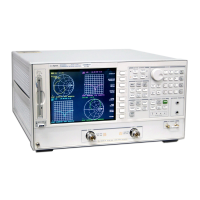





Do you have a question about the Agilent Technologies 8753ES and is the answer not in the manual?
| Brand | Agilent Technologies |
|---|---|
| Model | 8753ES |
| Category | Measuring Instruments |
| Language | English |
Overview of the topics covered in Chapter 1, focusing on measurement procedures and display functions.
Step-by-step guide for performing a fundamental measurement on the analyzer, including setup and parameter selection.
Essential functions for customizing and optimizing the analyzer display for readability and analysis.
Explains how to use markers for obtaining numerical readings and analyzing trace data.
Details procedures for measuring electrical length and phase distortion of devices.
Covers measurement techniques for amplifier characteristics like gain, compression, and isolation.
Guides on utilizing swept list mode for customized frequency sweeps, beneficial for high dynamic range devices.
Explains limit testing by creating and applying flat, sloping, and single-point limit lines.
Automates repetitive measurement tasks by recording and replaying keystrokes.
Overview of parameters the analyzer can measure for mixers and frequency converters.
Discusses challenges and factors crucial for successful mixer measurements.
Procedure for measuring mixer efficiency using frequency offset mode.
Details methods for measuring signal leakage (feedthrough) in mixers.
Explains time domain analysis for isolating device problems in time or distance.
Demonstrates how to analyze transmission response using time domain analysis.
Covers analyzing reflection response using time domain reflectometry (TDR) techniques.
Mode for band-limited devices, characterizing impulse response without DC restrictions.
Simulates TDR measurements to determine discontinuity types (resistive, capacitive, inductive).
Technique to selectively remove unwanted time domain responses for analysis.
Details how to output measurement results to various peripherals like printers and plotters.
Guides through setting up printer connections and parameters for outputting results.
Covers saving and recalling instrument configurations and measurement data.
Explains different methods and formats for saving measurement data to disk.
Essential techniques for proper connector care to ensure accurate measurements.
Identifies factors affecting accuracy and provides steps to improve measurement precision.
Addresses challenges and methods for accurately measuring devices with long electrical delays.
Techniques to optimize analyzer sweep speed by adjusting measurement settings.
Utilizes analyzer functions like averaging and bandwidth reduction to minimize trace noise.
Discusses factors influencing calibration accuracy and standard device selection.
Provides example procedures for various error correction types to enhance measurement accuracy.
Covers calibrating the analyzer receiver to accurately measure absolute power.
Describes the process of performing calibration using an ECal module for system error determination.
Explains the fundamental components and operation of the network analyzer system.
Details the sequence of math operations and data arrays used in signal processing.
Explains manual and automatic sweep time modes and their impact on measurement speed.
Defines S-parameters and the notation used to characterize device signal flow.
Covers various display formats like Log Magnitude, Phase, and Smith Chart for measured data.
Techniques such as averaging, smoothing, and IF bandwidth reduction to minimize trace noise.
Explains how calibration removes system errors to improve measurement accuracy.
Describes the different operating modes of the analyzer, including external source and tuned receiver.
Provides basic information on maintenance, assistance, and shipment for the instrument.
Explains safety symbols and their meanings used throughout the manual.
Crucial information on safe operation, handling, and power requirements for the instrument.
States compliance with various international safety and EMC standards.